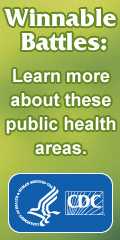June 2016
Did You Know? is a weekly feature from the Office for State, Tribal, Local and Territorial Support to inform your prevention activities. We invite you to read, share, and take action!
View the Current Did You Know?
June 24, 2016
- Sales of—and deaths from—prescription opioids have nearly quadrupled in the United States since 1999.
- At least 26 states require prescribers to check prescription drug monitoring programs (PDMPs)—electronic systems that track dispensing of controlled substances—before writing an opioid prescription.
- You can learn how states are using PDMPs, along with other strategies to improve public health, in CDC’s Prevention Status Reports.
June 17, 2016
- Preventing infections during dental treatment requires dental healthcare professionals to follow specific guidelines and recommendations [PDF-766KB].
- A new CDC study [PDF-260KB] found that failure to follow recommended precautions, such as improper equipment sterilization and unsafe injection practices, likely led to infections in dental settings
- Dental healthcare professionals can use CDC’s infection prevention practices summary and checklist [PDF-825KB] to review and ensure adherence to basic infection prevention principles.
June 10, 2016
- Legionnaires’ disease, a serious lung infection that kills about 1 in 10 people who get it, is on the rise, according to the latest Vital Signs report.
- Water management problems can lead to outbreaks of Legionnaires’ disease, which people get by breathing in mist containing the germ Legionella.
- You can provide tools and information to help building owners and managers create and use Legionella water management programs.
June 3, 2016
- Human metapneumovirus (HMPV)—a recently identified virus—can cause respiratory disease, especially in young children.
- HMPV leads to about 20,000 hospitalizations each year in the US among kids younger than 5 years.
- Healthcare professionals should consider HMPV, along with flu and respiratory syncytial virus (RSV), as a potential diagnosis when they see patients with respiratory illness, especially during late winter and early spring.
Did You Know? information and web links are current as of their publication date. They may become outdated over time.
- Page last reviewed: June 24, 2016
- Page last updated: October 13, 2016
- Content source:



 ShareCompartir
ShareCompartir



